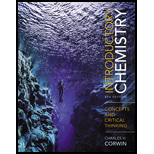
Concept explainers
(a)
Interpretation:
Whether the given substance would sink or float when dropped into water is to be stated.
Concept introduction:
The density is defined as the ratio of mass of a body to its volume. For solid bodies densities are usually expressed in the units of grams per cubic centimeter, for liquids in the units of grams per milliliter and for gases in units of grams per liter.
(b)
Interpretation:
Whether the given substance would sink or float when dropped into water is to be stated.
Concept introduction:
The density is defined as the ratio of mass of a body to its volume. For solid bodies densities are usually expressed in the units of grams per cubic centimeter, for liquids in the units of grams per milliliter and for gases in units of grams per liter.
Want to see the full answer?
Check out a sample textbook solution
Chapter 2 Solutions
Introductory Chemistry: Concepts and Critical Thinking Plus MasteringChemistry with eText -- Access Card Package
- Calculate the volume of 125g of the following liquids: a. Acetone (d=0.792g/mL) b. Olive oil (d=0.918g/mL) c. Chloroform (d=1.49g/mL)arrow_forwardCalculate the volume of 125g of the following liquids: a. Sea water (d=1.03g/mL) b. Methyl alcohol (d=0.792g/mL) c. Concentrated sulfuric acid (d=1.84g/mL)arrow_forwardReferring to Table 1.3, answer the following questions: a. Which is longer, a centimeter or an inch? b. How many milliliters are in a quart? c. How many grams are in an ounce?arrow_forward
- A bicycle accelerates from 5 miles per hour to 15 miles per hour. Does its energy increase or decrease? Is the change in potential energy or kinetic energy?arrow_forwardClassify the following as homogenous or heterogeneous: aThe contents of the beaker on the left in the photograph bThe contents of the beaker on the right in the photograph cReal lemonade made by squeezing lemons and adding sugar and water dBeach sandarrow_forwardAll molecules attract each other to some extent, and the attraction decreases as the distance between particles increases. Base on this idea, which state of matter would you expect has the stronges interaction between particles: solid, liquid or gasses?arrow_forward
- A pedon is a three dimensional body of soil that contains the minimum volume necessary to have all the physical properties necessary to classify as soil as to Series. true or falsearrow_forwardWhich one of the following is a homogeneous mixture: orange juice with pulp, wood, fog, bronze(made by melting copper and tin together)?arrow_forwardclassify whether it is greater than, less than, or equalarrow_forward
 Chemistry for Today: General, Organic, and Bioche...ChemistryISBN:9781305960060Author:Spencer L. Seager, Michael R. Slabaugh, Maren S. HansenPublisher:Cengage LearningChemistry: Matter and ChangeChemistryISBN:9780078746376Author:Dinah Zike, Laurel Dingrando, Nicholas Hainen, Cheryl WistromPublisher:Glencoe/McGraw-Hill School Pub Co
Chemistry for Today: General, Organic, and Bioche...ChemistryISBN:9781305960060Author:Spencer L. Seager, Michael R. Slabaugh, Maren S. HansenPublisher:Cengage LearningChemistry: Matter and ChangeChemistryISBN:9780078746376Author:Dinah Zike, Laurel Dingrando, Nicholas Hainen, Cheryl WistromPublisher:Glencoe/McGraw-Hill School Pub Co Introductory Chemistry: An Active Learning Approa...ChemistryISBN:9781305079250Author:Mark S. Cracolice, Ed PetersPublisher:Cengage Learning
Introductory Chemistry: An Active Learning Approa...ChemistryISBN:9781305079250Author:Mark S. Cracolice, Ed PetersPublisher:Cengage Learning Introductory Chemistry: A FoundationChemistryISBN:9781337399425Author:Steven S. Zumdahl, Donald J. DeCostePublisher:Cengage Learning
Introductory Chemistry: A FoundationChemistryISBN:9781337399425Author:Steven S. Zumdahl, Donald J. DeCostePublisher:Cengage Learning




